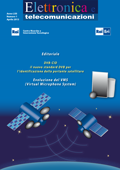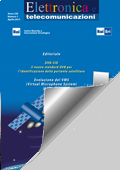
the complete interactive issue
(pdf, 144 dpi, 4.2 MB) |

the complete flipping issue
(swf flash, 144 dpi, 1.5 MB) |
|
(300 dpi, 682 KB) |
DVB-CID: the novel DVB standard for satellite carrier identification
by Vittoria Mignone and Bruno Sacco
Combating satellite interference, often caused by improperly configured equipment or failed equipment,has taken the industry by storm with unprecedented collaboration through industry groups. After years of industry debate, technical collaboration and, finally, a singular focus to push for a single standard, Carrier ID has arrived. in January 2013 the DVB Project announced a single standard for Carrier Identification: DVB-CID. That’s great news to the industry’s major satellite carriers, the broadcast community and industry groups that have rallied behind getting a viable technology deployed and standardized.
While it is not a perfect solution for solving all radio frequency (RF) interference, Carrier ID will enable operators and users to quickly identify interfering carriers. The new standard will allow Carrier ID to be virtually compatible with all satellite carriers today and easy to be included in all satellite modulators.
|

(300 dpi, 2,05 MB) |
VMS Evolution
by Leonardo Scopece
The VMS (Virtual Microphone System), based on the ambisonic theory, was created and patented by the Research Center and the University of Parma to allow, using a single probe,multimicrophonic recordings, thanks to the synthesis of a set of virtual microphones. The first implementation, based on an array of 32 microphone capsules positioned on a spherical probe, has been widely used since 2010, with very positive results. Later prototypes were made based on probes characterized by a different geometry, but that use similar user interface and allow the synthesis of the same number of virtual microphones. These configurations are targeted at specific objectives. A configuration based on a planar array is particularly suitable for shooting in television studios or theaters, in order to prevent the adoption of individual collar microphones. The last considered configuration is cylindrical, and is considered particularly suitable for music recordings, in the case of instruments close together, because it allows a greater directivity than the spherical configuration, and therefore a more detailed recording. The prototypes based on cylindrical and planar arrangements will shortly be tested in an anechoic chamber,and then in real operating conditions. |